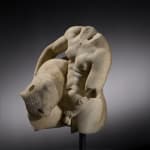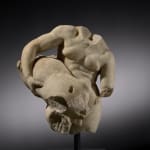Ancient Rome, first half of the 1st century
Marble
(22 in.)
Further images
State of conservation:
Torso of a marble Silenus with a wineskin on his bent right leg, holding it with his right arm. Missing parts: the head, the left underarm with the hand, the left leg, the right knee with the lower leg, some parts of the wineskin.
The piece is showing heavy incrustations on his back, whereas the surface on the front is well preserved. The piece had undergone some restorations that unfortunately have been again removed.
This is true for the head that had been fixed in a large insertion hole in the neck. That the head was originally worked in one part with the body is shown by the end of the beard curls that are still preserved. Another fixation hole is visible in the right leg; the same might be true for the left leg. Also the left underarm with the elbow had been restored1, while the arm was obviously worked in the original state in one piece with the body, as the tenon on the left hip is showing. On the wineskin, the front part and a larger broken part on the left side, as well as some smaller other parts were probably completed in cement that has been removed. The tool marks left by the removing of the cement look quite fresh, so that it must not be too long since somebody removed the modern restorations.
It is impossible to date these different restorations, but the latter one indicates that they are of the modern period, not antique. The heavy incrustations on the back lead to suspect that the statue
served after its discovery for a long time as decoration of a fountain where it has probably been placed in a niche with water flowing down close to its back, a hypothesis that might be further confirmed by the fact that the front was not exposed to rain.2 As this goes back without any doubt to the modern reuse of the statue, it must be therefore an old discovery, made somewhere between the 16th and the 19th century where fountains of this type were popular.
The provenance of the piece is unknown, but as most of the replicas of the same type have been found in Rome, there is a good chance that it comes also from the Eternal City or of its surroundings.
Style and chronology:
The modelling of the statue is of high quality, the muscles that are showing the age of the Silenus first of all on its breast, are worked out with sensibility. There are no sharp lines, the skin is moving smoothly, and small details as the little tail in the back and the beard curls (as far as they are still preserved) are worked out with care. There are not many indications that allow giving a precise date, but the careful, soft modelling, and the absence of the drill speak clearly in favor of the first century AD, most probably of the first half of the 1st century (Augustan period?).³
Identification of the statuary type:
Also in Antiquity, the statue served most probably as a fountain decoration, with the water flowing out of the wineskin. The hole in the middle of the wineskin might instead have served for cleaning purposes, and was probably closed by a cone, as this can be seen also in the replica in Newby Hall (fig. 3).
Statuary representations of Satyrs and Silenoi were often part of the decoration of Roman villas of the imperial period, to give it a Dionysian atmosphere.4 In the same time, precise statue types conserved in more than one replica are particularly rare, as this is e.g. the case of the so‐called 'Paposilenus Dresden‐Munich' that is attested in five replicas (fig. 7)5. The Silenus with the wineskin is another and up to today only partly known statue type of which I could find up to 7 (!) other replicas while only four of them known by literature6:
1. Rome, Villa Albani inv. 924 (ex Collezione Cesi) (fig. 1°‐1b)7
2. Rome, Palazzo Doria Pamphilj (fig. 2)8
3. Rome, Museo Torlonia (ex Galleria Giustiniani (fig. 3)9
4. Ripon/Yorkshire, Newby Hall (fig. 4)10
5. Christie's New York (sold in 2011 ex private collection in Austria) (fig. 5)11
6. Gorny & Mosch Munich, 2013, Auction 218 (fig. 6) 12
All the other replicas correspond very closely to each other, so that we can indeed speak of a statue type that must have been very popular during the Roman Imperial period. A. Linfert has proposed todate the original around 160 BC, but without excluding in the same time a possible Roman invention, underlining in the same time the orientation of the type on sculptures by Lysippus.13 Without a detailed and time consuming study of all of the replicas and a precise reconstruction of the original, no further hypothesis is proposed here.
In the series of the replicas, the statue discussed here is of particular interest, as it is, together with the replica in Newby Hall (fig. 4) the most precise, and in the same time, as far as it can be said for now, probably the earliest copy of this statue type. The workmanship is very careful, the modelling of the skin exceptionally fine. One can only regret that the modern restorations have been removed, as an important part of the story, its reuse during the modern period, that the statue had to tell, got lost.
1 I cannot see on the available pictures if there is a fixation hole in the arm.
2 A similar exhibition of a statue of the same type in a niche is given by the drawing by Sandrart of the replica ex
Galleria Giustiniani, now in the Villa Torlonia (fig. 3, see below).
3 See for a comparison the replica in Newby Hall (fig. 4), dated around 100 AD, and that is showing on the
breast a much harder modelling.
4 See Neudecker 1984, p. 47‐54.
5 Dresden, Staatl. Skulpturensammlung, Munich, Glyptothek inv. Gl. 221, Narbonne, Musée archéologique,
Paris, Musée du Louvre Inv. MA 291, Rhodos, Archaeological Museum Inv. BE 780. To be included here is the
mirrored, rather poor variant in Lyon (fig. 8)
6 The only published short study of the type is counting only four replicas: Boschung & von Hesberg 2007, 54‐56
no. N 13 pl. 23, 2. 4; 24. 25, 1‐3.
7 Bol 1988, p. 107‐108 cat. 27 pl. 48‐49 with former bibliography. Identified with a replica formerly conserved in
the Palazzo Cesi and represented e.g. on an engraving form 1581 by Pieter Perret (fig, 2;
https://www.artic.edu/artworks/221703/fountain‐with‐silenus‐in‐the‐garden‐of‐the‐cesi‐palace‐near‐rome,
last consultation 9.12.2018); see Boschung & v. Hesberg 2007, 55 no. 1 with bibliography in n. 1.
8 Calza 1977, p. 80‐81 no. 90 pl. 58; Boschung & v. Hesberg 2007, 55 no. 3 with bibliography in n. 4.
9 Boschung & v. Hesberg 2007, 55 no. 1 with bibliography in n. 2. Drawing by Sandrart (before 1675):
https://skd‐online‐collection.skd.museum/Details/Index/886010 (last consultation 9.12.2018); print of the
same drawing: http://ta.sandrart.net/‐artwork‐638 (last consultation 9.12.2018)
10 Boschung & v. Hesberg 2007, 54‐56 no. N 13 pl. 23, 2. 4; 24. 25, 1‐3.
11 https://www.christies.com/zh‐CN/lotfinder/lot_details.aspx?intobjectid=5509221 (last consultation:
30.10.2018)
12 https://www.gmcoinart.de/Auktion_Detailseite.AxCMS?lager=00106&los=3 (last consultation: 30.10.2018)
13 A. Linfert in: Boschung & v. Hesberg 2007, 56.
Provenance
Swiss private collection
Literature
D. Boschung & H. von Hesberg, Die antiken Skulpturen in Newby Hall sowie in anderen Sammlungen in Yorkshire, Wiesbaden, 2007, 54‐56 no. N 13 pl. 23, 2. 4; 24. 25, 1-3.
P.C. Bol, Satyr mit Weinschlauch, in: P.C. Bol, ed., Forschungen zur Villa Albani.
Katalog der antiken Bildwerke I. Bildwerke im Treppenaufgang und im Piano nobile des Casino, Mann: Berlin, 1988, p.107‐108 cat. 27 pl. 48‐49
R. Calza, ed., Antichità di Villa Doria Pamphily, Rome, 1977, p. 80‐81 no. 90 pl. 58
R. Neudecker, Die Skulpturenausstattung römischer Villen in Italien, Beiträge zur Erschliessung hellenistischer und kaiserzeitlicher Skulptur und Architektur vol. 4, Mainz, 1988, p. 47‐54
Online:
Printable 3D model of the statue:
https://www.myminifactory.com/de/object/3d‐print‐a‐roman‐marble‐silenius‐74403 (last consultation: 1.12.2018)





